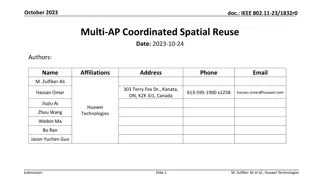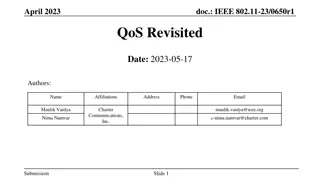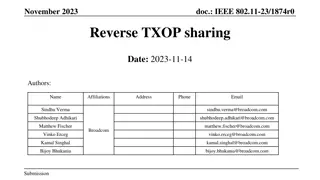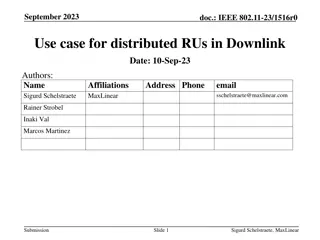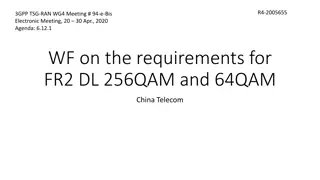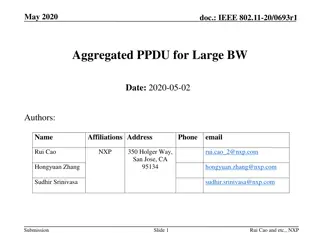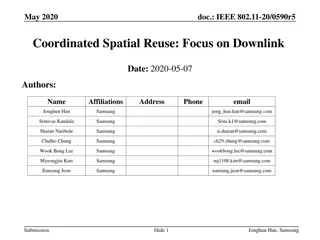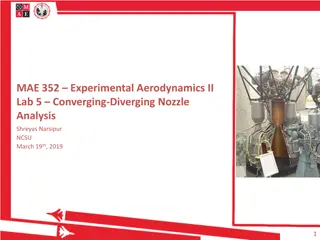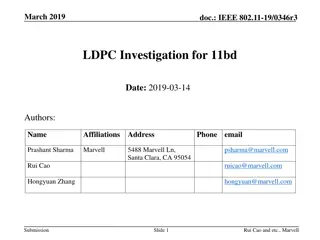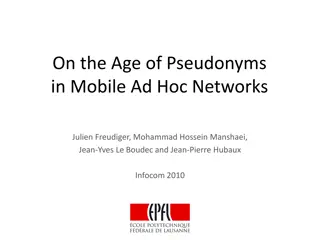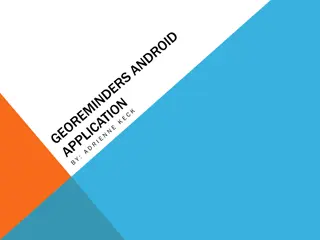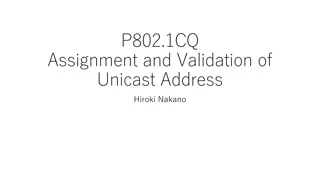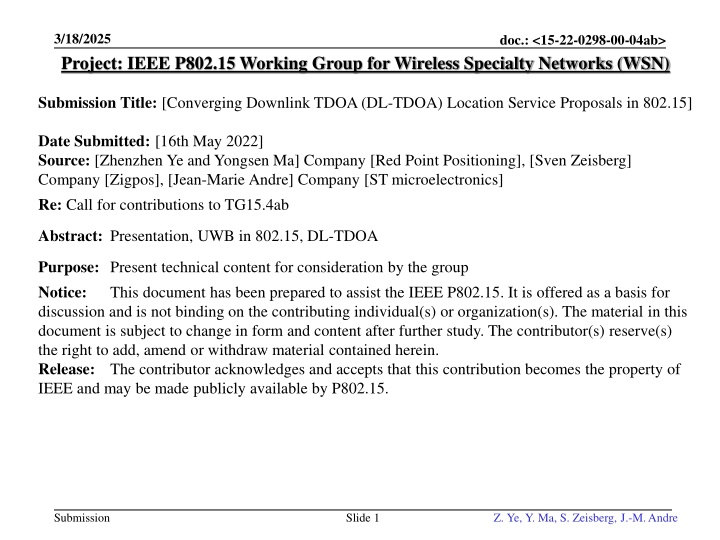
Converging DL-TDOA Location Service Proposals in IEEE 802.15
Explore the convergence of Downlink Time Difference of Arrival (DL-TDOA) location service proposals in the IEEE 802.15 Working Group for Wireless Specialty Networks. This submission presents technical content addressing interference mitigation, coexistence improvement, enhanced reliability, and other key aspects to support various use cases. Learn about proposed solutions, safeguards, and advancements in MAC enhancements for DL-TDOA scheduling. Discover the contribution recap and previous work related to DL-TDOA systems within IEEE 802.15 standards.
Download Presentation

Please find below an Image/Link to download the presentation.
The content on the website is provided AS IS for your information and personal use only. It may not be sold, licensed, or shared on other websites without obtaining consent from the author. If you encounter any issues during the download, it is possible that the publisher has removed the file from their server.
You are allowed to download the files provided on this website for personal or commercial use, subject to the condition that they are used lawfully. All files are the property of their respective owners.
The content on the website is provided AS IS for your information and personal use only. It may not be sold, licensed, or shared on other websites without obtaining consent from the author.
E N D
Presentation Transcript
3/18/2025 Project: IEEE P802.15 Working Group for Wireless Specialty Networks (WSN) doc.: <15-22-0298-00-04ab> Submission Title: [Converging Downlink TDOA (DL-TDOA) Location Service Proposals in 802.15] Date Submitted: [16th May 2022] Source: [Zhenzhen Ye and Yongsen Ma] Company [Red Point Positioning], [Sven Zeisberg] Company [Zigpos], [Jean-Marie Andre] Company [ST microelectronics] Re: Call for contributions to TG15.4ab Abstract: Presentation, UWB in 802.15, DL-TDOA Purpose: Present technical content for consideration by the group Notice: This document has been prepared to assist the IEEE P802.15. It is offered as a basis for discussion and is not binding on the contributing individual(s) or organization(s). The material in this document is subject to change in form and content after further study. The contributor(s) reserve(s) the right to add, amend or withdraw material contained herein. Release: The contributor acknowledges and accepts that this contribution becomes the property of IEEE and may be made publicly available by P802.15. Submission Slide 1 Z. Ye, Y. Ma, S. Zeisberg, J.-M. Andre
3/18/2025 PAR Objective doc.: <15-22-0298-00-04ab> Proposed Solution (how addressed) Safeguards so that the high throughput data use cases will not cause significant disruption to low duty-cycle ranging use cases Interference mitigation techniques to support higher density and higher traffic use cases The proposed method for DL-TDOA scheduling is used to reduce interference between participating anchors. DL-TDOA supports a high density of tags without increasing interference potential. Other coexistence improvement Backward compatibility with enhanced ranging capable devices (ERDEVs) The proposed MAC enhancements are compatible with legacy ERDEVs; All required information is conveyed using IEs in existing MAC frame formats harmlessly ignored by non-participating legacy devices. Improved link budget and/or reduced air-time Additional channels and operating frequencies Improvements to accuracy / precision / reliability and interoperability for high-integrity ranging Reduced complexity and power consumption The new feature will provide enhanced reliability in some high density use cases. Hybrid operation with narrowband signaling to assist UWB Enhanced native discovery and connection setup mechanisms Sensing capabilities to support presence detection and environment mapping Low-power low-latency streaming Option allowed to offload network discovery and device management to NB channels Higher data-rate streaming allowing at least 50 Mbit/s of throughput Support for peer-to-peer, peer-to-multi-peer, and station-to-infrastructure protocols Infrastructure synchronization mechanisms The proposed superframe structure, transmission scheme and messages are to support downlink TDOA location service. Proposed IE(s) supports synchronization for downlink TDOA network infrastructure Submission Slide 2 Z. Ye, Y. Ma, S. Zeisberg, J.-M. Andre
3/18/2025 doc.: <15-22-0298-00-04ab> Recap: Previous Contributions Two types of system designs for providing DL-TDOA location service List of IEEE 802.15.4ab contributions related to DL-TDOA location systems (by 03/2022, ordered by groups of authors: 1. Zhenzhen Ye (Redpoint): Reverse TDOA Applications and Technical Characteristics. IEEE 15-21-0223-00-04ab, 2021-04-27, IEEE 802.15 TG4ab 2. Zhenzhen Ye (Redpoint): Downlink TDOA (DL-TDOA) Location Service in 802.15. IEEE 15-21-0488-00-04ab, 2021-09-15, IEEE 802.15 TG4ab 3. Yongsen Ma, Zhenzhen Ye (Redpoint): Beacon and Ranging Frames to Support Downlink TDOA (DL-TDOA) Location Service in 802.15. IEEE 15-21-0616-01-04ab, 2021-11-16, IEEE 802.15 TG4ab 4. Sven Zeisberg, Jean-Marie Andr : 802.15.4z upgrade requirements for larger industrial scenarios. IEEE 15-21-0066-00-04ab, 2021-01-20, IEEE 802.15 SG4ab 5. Jean-Marie Andr , Sven Zeisberg: DL-TDOA positioning TDMA scheme. IEEE 15- 21-0530-00-04ab, 2021-10-19, IEEE 802.15 TG4ab 6. Jean-Marie Andr (ST microelectronics), Sven Zeisberg (HTW), Vincent van der Locht (SynchronicIT), Frank Stephan (ZIGPOS), Andreas Schumacher (TRUMPF): TDMA scheme enabling industrial DL-TDoA and UL-TDoA scenarios. IEEE 15-22- 0077-00-04ab, 2022-01-2, IEEE 802.15 TG4ab 7. Jean-Marie Andr (ST microelectronics), Sven Zeisberg (HTW), Vincent van der Locht (SynchronicIT), Frank Stephan (ZIGPOS), Andreas Schumacher (TRUMPF): Information Elements for efficient DL-TDoA. IEEE 15-22-0113-00-04ab, 2022-02, IEEE 802.15 TG4ab Submission Slide 3 Z. Ye, Y. Ma, S. Zeisberg, J.-M. Andre
3/18/2025 doc.: <15-22-0298-00-04ab> Recap: Previous Contributions (Cont d) Similarity between two designs Block-based frame structure by extending/adopting 802.15.4z ranging block structure in multi-node ranging (sec. 6.9.7) Infrastructure synchronization with signals from a subset of devices Support of different ranging modes (DL-TDOA, UL-TDOA, etc.) in the proposed block-based frame structure Difference between two designs The specific ways of organizing ranging messages to provide TDOA information Specific IEs defined to support DL-TDOA service Availability of TDMA scheduled time slots and CAP for UL messages vs. availability of only CAP for UL-messages, TW- messages and in-band data Next steps How to extend 802.15.4 toolbox to enable both designs Submission Slide 4 Z. Ye, Y. Ma, S. Zeisberg, J.-M. Andre
3/18/2025 doc.: <15-22-0298-00-04ab> Similarity Block Structure M=2: two slots per round (anchor pair) M>2: anchor cluster Superframe based structure [2] BOP: beacons from a subset of anchors for synchronization and superframe info broadcast CFP: a ranging block structure supporting DL- TDOA messages from anchors grouped into pairs or clusters CAP: contention period to support other ranging modes (UL-TDOA, TWR, etc.) and in- band data communications. A variety of ranging and data traffic is supported in the same CAP. Ranging block & round based structure [5-6] xRCP: control messages from controllers for block/round control, synchronization and DL- TDOA INIT: 2 sub-phases for first BPS and 2nd MPS/FBS, both for DL-TDOA, in which messages from satellites (anchors) are scheduled RSP: a contention-free/contention period (mode per round) to support UL-TDOA, scheduled TWR, RToF, TsToF Submission Slide 5 Z. Ye, Y. Ma, S. Zeisberg, J.-M. Andre
3/18/2025 doc.: <15-22-0298-00-04ab> Similarity Infrastructure Synchronization Contributions [2-3] A mesh network topology A subset of anchors are selected to transmit beacons which contains timing info Other anchors in the network use timing info in beacons to handle synchronization Contributions [5-6] Satellites (anchors) are in groups and there are several controller per satellite group All anchors transmit various messages containing timing info Other satellites use these messages to allow a variety of synchronization schemes Submission Slide 6 Z. Ye, Y. Ma, S. Zeisberg, J.-M. Andre
3/18/2025 doc.: <15-22-0298-00-04ab> Similarity Ranging Modes supported Contributions [2-3] DL-TDOA: in the CFP, anchors pairs or clusters are scheduled to transmit in corresponding ranging rounds/slots so that a tag can calculate TDOA values from these messages UL-TDOA, TWR: in the CAP, both anchors and tags are allowed to transmit so either UL-TDOA or TWR are supported Contributions [5-6] DL-TDOA: in the xRCP and INIT periods, satellites are scheduled to transmit frames containing time relation info, so that a tag can calculate TDOA; DL-TDOA info is sent equally separated in time within a block at each position UL-TDOA, scheduled TWR, RToF, TsToF in RSP period together with xRCP and INIT periods, tags are allowed to transmit either in a scheduled round or in a CAP round Submission Slide 7 Z. Ye, Y. Ma, S. Zeisberg, J.-M. Andre
3/18/2025 doc.: <15-22-0298-00-04ab> Difference DL-TDOA derivation Contributions [5-6] Satellites (controllers and initiators) are not required to be grouped into pairs or clusters, but provide time relation info relative to neighbors Satellites transmit messages in xRCP and INIT phases in each ranging round, which are integrating multiple ranging methods A tag ( responder ) may derive TDOA values from several messages if satellites are either well synchronized or time relation info between them has been received Contributions [2-3] Anchors are explicitly grouped into pairs or clusters so the TDOA values are generated from these pairs or clusters Submission Slide 8 Z. Ye, Y. Ma, S. Zeisberg, J.-M. Andre
3/18/2025 doc.: <15-22-0298-00-04ab> Difference - IEs Contributions [2-3] New Header IE and Payload IE for the beacon frame New Header IE and Payload IE for DL-TDOA ranging frame Contributions [6-7] A combination of existing IEs from 4z and a group of complementary new proposed IEs, where all IEs, which are relevant for DL-TDoA tags reception are assumed to become header IEs Some functional overlap: Beacon HIE XRCM IE, RDM IE, ARC IE, XOCM IE? Ranging PIE RR IE, RRTI IE, XTxTime IE, XCFO IE, XPos IE? Submission Slide 9 Z. Ye, Y. Ma, S. Zeisberg, J.-M. Andre
3/18/2025 doc.: <15-22-0298-00-04ab> Next Steps How to extend the IEEE 15.4 toolbox enabling these two designs? 1. Block structure alignment options: Example a): try to fit [5-6] into [2-3] approach: BOP = xRCP, CFP = INIT (for DL-TDOA, with flexible ranging slot configuration in a ranging round, # of slots>=1), CAP = RSP # of slots >=2: the scheme with anchors grouped as pairs or clusters [2-3] CAP to support scheduling mode as that in RSP Example b): try to fit [2-3] into [5-6] approach: xRCP are carrying block/round org contents (in case no OOB avail.) as the BOP, the INIT carry several slots for several pairs or cluster anchors and the RSP may be extended to allow anchor Tx as that in CAP further discussion and harmonization Submission Slide 10 Z. Ye, Y. Ma, S. Zeisberg, J.-M. Andre
3/18/2025 doc.: <15-22-0298-00-04ab> Next Steps (Cont d) How to extend the IEEE 15.4 toolbox enabling these two designs? 2. IE design considerations Information in header IE or payload IE section split A few bigger IEs vs a set of small IEs Possible alignment with concurrent work in other standard forums OoB and IB Options to support other ongoing TG4ab initiatives [8, 9, 10] further discussion and harmonization 3. Conclusion: a common framework based on extending 15.4(z) supporting both designs seems possible (further) examples/options need to be discussed and evaluated Submission Slide 11 Z. Ye, Y. Ma, S. Zeisberg, J.-M. Andre
3/18/2025 doc.: <15-22-0298-00-04ab> References 1. Zhenzhen Ye (Redpoint): Reverse TDOA Applications and Technical Characteristics. IEEE 15-21-0223-00-04ab, 2021-04-27, IEEE 802.15 TG4ab Zhenzhen Ye (Redpoint): Downlink TDOA (DL-TDOA) Location Service in 802.15. IEEE 15-21-0488-00-04ab, 2021-09-15, IEEE 802.15 TG4ab Yongsen Ma, Zhenzhen Ye (Redpoint): Beacon and Ranging Frames to Support Downlink TDOA (DL-TDOA) Location Service in 802.15. IEEE 15-21-0616-01-04ab, 2021-11-16, IEEE 802.15 TG4ab Sven Zeisberg, Jean-Marie Andr : 802.15.4z upgrade requirements for larger industrial scenarios. IEEE 15-21-0066-00-04ab, 2021-01-20, IEEE 802.15 SG4ab Jean-Marie Andr , Sven Zeisberg: DL-TDOA positioning TDMA scheme. IEEE 15-21- 0530-00-04ab, 2021-10-19, IEEE 802.15 TG4ab Jean-Marie Andr (ST microelectronics), Sven Zeisberg (HTW), Vincent van der Locht (SynchronicIT), Frank Stephan (ZIGPOS), Andreas Schumacher (TRUMPF): TDMA scheme enabling industrial DL-TDoA and UL-TDoA scenarios. IEEE 15-22-0077-00-04ab, 2022-01-2, IEEE 802.15 TG4ab Jean-Marie Andr (ST microelectronics), Sven Zeisberg (HTW), Vincent van der Locht (SynchronicIT), Frank Stephan (ZIGPOS), Andreas Schumacher (TRUMPF): Information Elements for efficient DL-TDoA. IEEE 15-22-0113-00-04ab, 2022-02, IEEE 802.15 TG4ab J.S. Hammerschmidt, Ersen Ekrem, Eren Sasoglu, Xiliang Luo (Apple): Narrowband assisted multi-millisecond UWB. IEEE 15-21-0409-00-04ab, 2021-07, IEEE 802.15 TG4ab Ersen Ekrem, et al., NBA-UWB Technical Framework Proposal. IEEE-15-22-xxxx-00- 004ab, 2022-03, IEEE 802.15 TG4ab Billy Verso, et al. (Qorvo), Multi-millisecond Ranging, IEEE-15-22-0205-00-04ab, 2022-03, IEEE 802.15 TG4ab 2. 3. 4. 5. 6. 7. 8. 9. 10. Submission Slide 12 Z. Ye, Y. Ma, S. Zeisberg, J.-M. Andre

